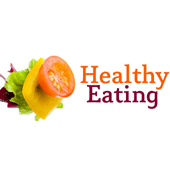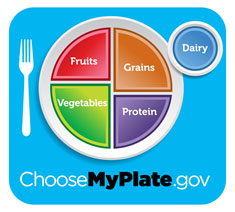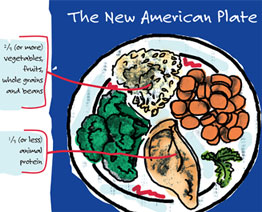
When did eating become so complicated? Did God really intend for us to invest so much brainpower and effort into fueling and nourishing our bodies?
If you cut through all the evidence and advice, the bottom line is that healthy eating means choosing from a variety of foods for meals and snacks, and ultimately learning to trust our hunger and fullness signals to determine how much we should eat. The truth is, nutrition is not an exact science, and no one person—including experts—has all the answers.
What’s a simple way to approach making healthy food choices? I like using the “healthy plate” concept as a guide for putting together meals. There are different variations of it, so pick what best suits you and your tastes. Here are two examples:
The idea is to try to include items from all of the food groups at each meal. Don’t worry about fitting everything exactly on one plate as shown in the diagrams, however. If you have a separate bowl of fruit on the side, for example, imagine that as part of the plate. Also, if you have mixed dishes such as stir-fries, lasagna, burritos or casseroles, picture the main ingredients separated out into the different food group segments. If one of the groups is empty, try supplementing with other foods as needed to round out the meal.
Since each person is a unique combination of age, body type, activity level and metabolism, the amount of food needed to fuel our bodies will vary. For example, my still-growing, lacrosse-playing teenage son is often hungry for two or three times the portions sizes of my meals, necessitating more than one plate. The amount required to satisfy each body’s needs also varies depending on the day. Since the healthy-plate graphics are only general guidelines, don’t take the concept too literally when deciding how much to eat—or even what to eat.
Here at FINDINGbalance, we teach people to strive to make healthy food choices about 90% of the time. That leaves 10% wiggle room for moderate amounts of “fun foods” or “treat foods” that don’t score high on the nutrient value scale, but sure taste good. This could translate into two to three less-healthy meals a week or a less-healthy item once a day. So don’t stress about having a fast-food meal on a hectic day, enjoying a piece of chocolate or celebrating a birthday with cake.
Again, these are simple guidelines and not a strict set of rules or calculations. They are just teaching tools, here to help and serve you.
Along those lines, if you are someone who hardly ever makes healthy food choices, the 90% “healthy food choices” goal is something to aim for over time. Any step in that direction is a positive one, so don’t beat yourself up if you’ve got farther to go than some other folks.
It’s also important to note that those who are recovering from disordered eating, may need to follow a very specific prescribed meal plan for the time being, to restore your health and relearn hunger and fullness cues. If this applies to you, an experienced dietitian can help you with that. Eventually, you will get to the place of freer, simpler eating.
Related Articles:
A Healthy Diet for a Healthy Weight
Understanding Hunger and Fullness Cues
Eating Treat Foods without Guilt
Related Books:



Dear Ann,
I have been having a hard time breaking out of a very restrictive diet…vegan with oil only from nuts and avocado; no grains hardly and very sporadic starchy veggies. Mostly veggies, fruits, beans and some nuts. I pursue thinness too much and don’t like that focus. Finally I end up binging sooner or later. My biggest difficulty breaking out is how bad I feel eating more normal foods. It is hard at first to eat more moderate amounts. I aim to eat three meals, but they can be somewhat large (ie three eggs and two pieces of toast for breakfast) and my body feels bad (especially from sugar and bread). Will my body get used to eating these foods again? Will they stop feeling so bad? I really want to eat more normally.
Lisa J
Lisa,
The fears and concerns you are describing are typical for someone trying to break free from a restrictive eating mindset. It sounds like you approach eating in an “all-or-nothing” manner. Either you stick with very limited “safe foods” or feel like you lose control and binge. If you are not already seeing a professional, I highly recommend that you seek someone to help you move towards freedom. Also, check out the article “Eating Treat Foods Without Guilt.” (Click on the link under “Related Articles.”
Reintroducing foods back into your diet can cause some physical distress such as gastrointestinal symptoms, because your body needs time to start remaking enzymes to digest them. It will adjust! If small amounts continue to cause problems, however, talk it over with your health care provider to rule out food intolerances or sensitivities.
I wish you the best!
Hi Ann,
This helps to make things more concrete for me. Thank you.
Eugene,
Glad you found this helpful. For more information, check out the related article, “A Healthy Diet for a Healthy Weight.”